
A great IT strategy is one way to separate tomorrow’s winners from tomorrow’s losers. Whether you’re entering a new phase of organizational development or building IT capabilities from scratch, you need to have a central document explaining what your company’s technology will look like.
In other words, your IT strategy is not just a “nice to have” document piece of support for your business goals. In today’s connected world, if you don’t have strong IT support, you simply won’t be able to do business. And even in low-tech organizations, digital savviness, and adoption have got to be on your radar.
So, it’s really important to take an intelligent approach to thinking about IT.
This article will take you through the highs and lows of creating a great IT strategy. We’ll explain precisely what an IT strategy is, what it does, and why it’s important for any business. We’ll share the key features that any CIO should put into their strategy documents and think about the wider context for leveraging IT properly.
All business strategies have a risk of failure. Fortunately, there is plenty of smart advice out there to make sure yours succeed. Let’s get started and see where it takes us.
What Is An IT Strategy?
In its biggest sense, IT Strategy includes all the principles, plans, and processes behind an organization’s technology. With good strategic planning, everything in the IT strategy is closely aligned with the overall business strategy. The strategic planning process shows how technology can create value in the company.
Let’s look at three areas that will take this definition deeper. We need to know what documents go into a strategic plan; how it differs from general business strategy; and the tools you can leverage to make the best IT strategy.
So is a strategy anything more than a strategic plan?
A strategic plan is a vital part of the IT strategy (and we’re going to talk about strategic plans more below).

But the overall IT strategy can include:
- A vision statement, a strategy story, or another high-level explanation of the purpose of technology in the company. At this level, it won’t show the specific approaches or priorities – just the big-picture goals.
- The details of purchasing, implementation, and timeline will start to appear in the IT Strategic plan.
- To communicate the plans better with staff at every level, a roadmap can indicate key information clearly and concisely. For example, this may be a visual representation of the journey through a swimlane diagram or timeline. The roadmap is a great way to explain and clarify a complex and technical strategy to non-technical business leaders.
- If you are using Agile methodology to implement an IT strategy, your work will produce regular report cards that report on your progress and challenges.
If you combine all of these documents, you have the tools to ensure that technology works for your organizational goals.
How is an IT strategy different from other types of business strategy?
An IT strategy will always be the servant of the wider business strategy.
Business strategy is an art form in itself. One classic 2012 article from BCG, “Your strategy needs a strategy,” shows how. While business leaders must plan their strategy based on many factors, they also have opportunities to style that suit them best.
However, when we get down to more specific business units, strategy plans have got less room to decide their own approach. Whether an overall approach to strategy is “classic,” “adaptive,” “visionary,” “shaping,” or “renewal,” the IT strategy will have to follow in these footsteps.
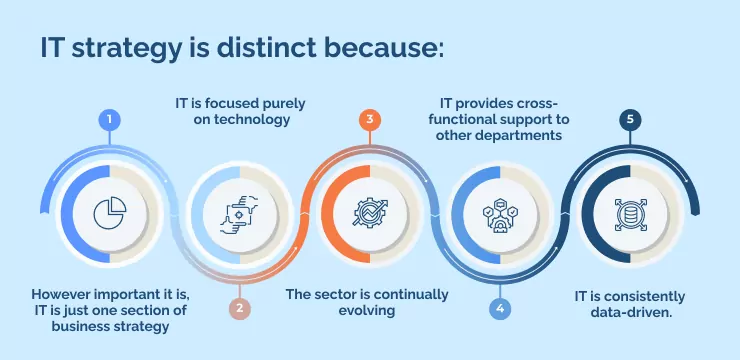
IT strategy is distinct because:
- However important it is, IT is just one section of business strategy
- IT is focused purely on technology
- The sector is continually evolving
- IT provides cross-functional support to other departments
- IT is consistently data-driven.
All the same, IT strategy is an increasingly important part of any business’s plans for success. Tech-heavy companies may choose to produce their IT and business strategies in tandem.
What tools can help create an IT strategy?
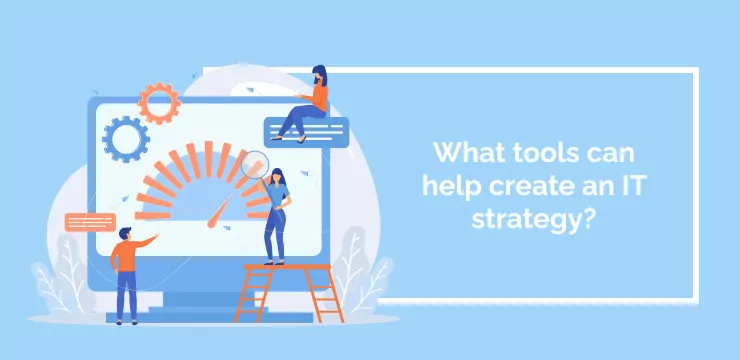
IT strategy isn’t easy, but there are many off-the-shelf toolkits that help technology leaders define their choices.
The major IT governance systems give an astute guide to the future. ITIL (Information Technology Infrastructure Library) and COBIT (Control Objectives for Information and Related Technology) provide the tools to ensure their IT investments deliver value, manage risk effectively, and align with business goals.
ITIL and COBIT can be adapted to fit an organization’s specific needs, but it’s important to have someone on the team who understands the frameworks and how to apply them.
As well as these major services, small tools like SWOT analysis, Porter’s Five Forces, and the Balanced Scorecard are useful for developing a strategy.
Why Is An IT Strategy Important?
In the words of Volker Johanning, “Companies are not only partially dependent on IT—they cannot exist at all without IT” (IT Strategy: Making IT Fit for the Digital Transformation, 2022). In other words, IT strategy isn’t an optional extra for technology-evangelistic companies. Every company has one (whether they know it or not). It’s up to business leaders to make sure that the strategy works well.
At the most basic level, IT strategy ensures that the company’s technology is aligned with business objectives. The choices about IT don’t happen by accident – they are thoroughly designed to achieve the support the organization’s goals.
This alignment supports resource optimization throughout the organization and guarantees that technology is efficient and value-creating.
The strategy will continuously seek opportunities to use emerging technology, create meaningful value, and monitor success.
Whenever you purchase a single piece of hardware or software, you’ve made a strategic decision – even if you didn’t know it. It’s much better to take IT strategy seriously so each decision is the best.
What Should Be In A CIO’s Strategic Plan?
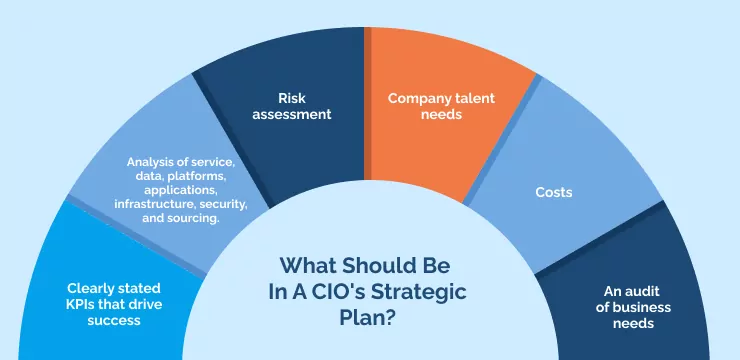
The strategic plan document is the most important part of IT strategy. It’s the place where dreams become a reality – and the future state of your company’s IT provision is explained in black and white.
Of course, the precise makeup of a strategic plan will depend on its scope and focus. The company’s overall maturity and wider industry trends will also have an impact on the make-up of the document.
All the same, when a CIO is creating an IT strategy, they should aim to include at least some of these critical elements:
- Clearly stated KPIs that drive success
- Analysis of service, data, platforms, applications, infrastructure, security, and sourcing.
- Risk assessment
- Company talent needs
- Costs
- An audit of business needs.
None of these areas are as simple as they seem. In an area of business expertise that’s constantly changing, it’s tough just to stay ahead of the game.
How to create your IT strategy in 2023
So – how are you going to create your strategy? In this section, we’ll break it down into three parts.
First, we’ll talk about business alignment. Then, we’ll examine some of the steps you can go through. Then, we’ll give you an overview of some of the best practices in the field.
Alignment: The top Priority for IT Strategy in any year

Alignment is more important than ever. A 2023 Forrester guide explains, “As organizations break out of traditional IT models, they expect their tech execs to take a stake and partner with business leaders to align tech strategies with the delivery of long-term customer value.” In other words, IT capabilities should feed directly into profit-generating products.
So, when IT strategist sits down to devise their KPIs, they must include business outcomes alongside simple metrics of digital success. Whether the strategy is making a few tweaks or offering full digital transformation – if it doesn’t impact the business positively, it isn’t really relevant.
A clear-headed IT strategist has to face many problems that would interfere with alignment. They will include:
- Mis-placed enthusiasm for new technology (especially from non-technical leadership)
- Changes in leadership and business strategy
- Poor communication within the organization
One of the key tools for the ongoing success of strategy is a DAP – a digital adoption platform – which shows you how digital assets are used throughout the company.
The Steps You Need to Go Through
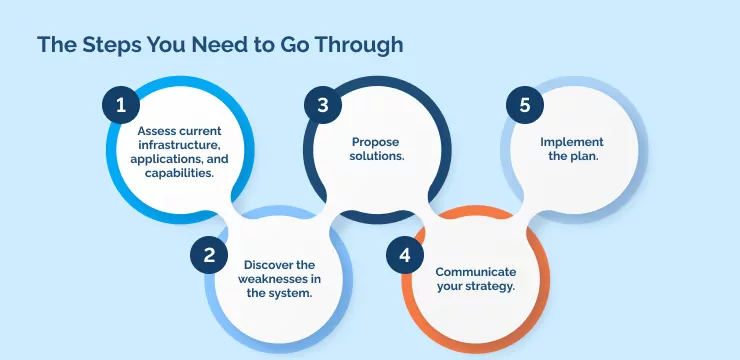
There are many ways to achieve a solid IT strategy. But if you’re not sure where to start – the following steps will be a good starting point.
- Assess current infrastructure, applications, and capabilities. This involves identifying the hardware, software, and other technological resources currently in use and evaluating the company’s ability to use those resources to achieve its business goals. This information can be gathered through surveys, interviews, and other data collection methods.- SWOT analysis
- Discover the weaknesses in the system. This may involve identifying areas where the technology is not meeting business needs, causing inefficiencies or unnecessary costs, or putting the company at risk. This process may involve conducting a risk assessment, analyzing performance metrics, and gathering feedback from stakeholders.
- Propose solutions. This is often the most complex part of the process, as there are likely to be many potential solutions and trade-offs to consider. Solutions may involve upgrading existing technology, implementing new technology, or changing business processes to better align with technology capabilities.
- Communicate your strategy. presentations, reports, or other materials that clearly explain the strategy and its benefits. As we’ve already mentioned, a roadmap might a strong tool here. Effective communication is critical to gaining buy-in and support for the strategy.
- Implement the plan. The final step is to put the proposed solutions into action. That may include deploying new technology, training employees, and modifying business processes. Implementation should be carefully planned and executed to minimize disruption to business operations and ensure that the strategy is effective in achieving its intended goals.
Best Practices for IT Strategy
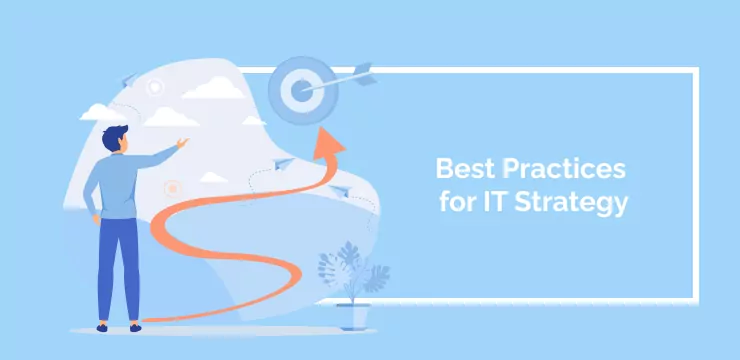
A good IT strategy requires a particular type of mindset. Let’s look at some of the ways to ensure success in this complex discipline.
IT strategy should involve IT experts who can provide technical guidance and ensure that the strategy is feasible and can be implemented successfully.
However, those experts must go outside their siloes and listen to people from across the company. That will include managerial staff – but it should also extend to the grassroots experiences of the IT universe.
That’s because IT strategy should have stakeholder buy-in, including executives, IT staff, and end-users, to ensure successful adoption and implementation. Of course, it’s not possible to please everyone all the time: but people must understand that they’ve been heard.
After the strategy is in place, the IT team must be ready to adapt the plan whenever it’s necessary. New business priorities will come along, natural disasters may change things, and emerging technology may
Finally, an IT strategy should be prepared for scalability and flexibility
Special Considerations for Your IT strategy In 2023
So when you’re thinking about the IT strategy for 2023 and beyond – what do you need to reflect on?
Of course, you’ll always have to deal with the rapid change of technical advancement, competition with other businesses, and the restrictions (or freedoms!) of budget and spending within your organization.
But in 2023, you’ll have to think about some key technology developments – including cloud computing, social media, virtualization, and mobility. All of these concerns bring problems for data security with them – a breach could compromise your whole business.
A recent insight report from McKinsey mentioned many of these factors. On top of them, they emphasized that the working experience of developers and IT professionals should be a crucial part of an ongoing strategy.
A Powerhouse IT Strategy Is King
For years, management experts have known that strategic planning is vital for leveraging technology. As a 2015 Deloitte report put it – “strategy, not technology, drives digital transformation.”
There is now a large and engaging library of information about IT strategy out there – in professional guidelines, academic research, and business consultancy. Find the right approach for your company, produce an implementation plan, and you can expect a highly successful digital future.
WalkMe Team
WalkMe spearheaded the Digital Adoption Platform (DAP) for associations to use the maximum capacity of their advanced resources. Utilizing man-made consciousness, AI, and context-oriented direction, WalkMe adds a powerful UI layer to raise the computerized proficiency, everything being equal.



